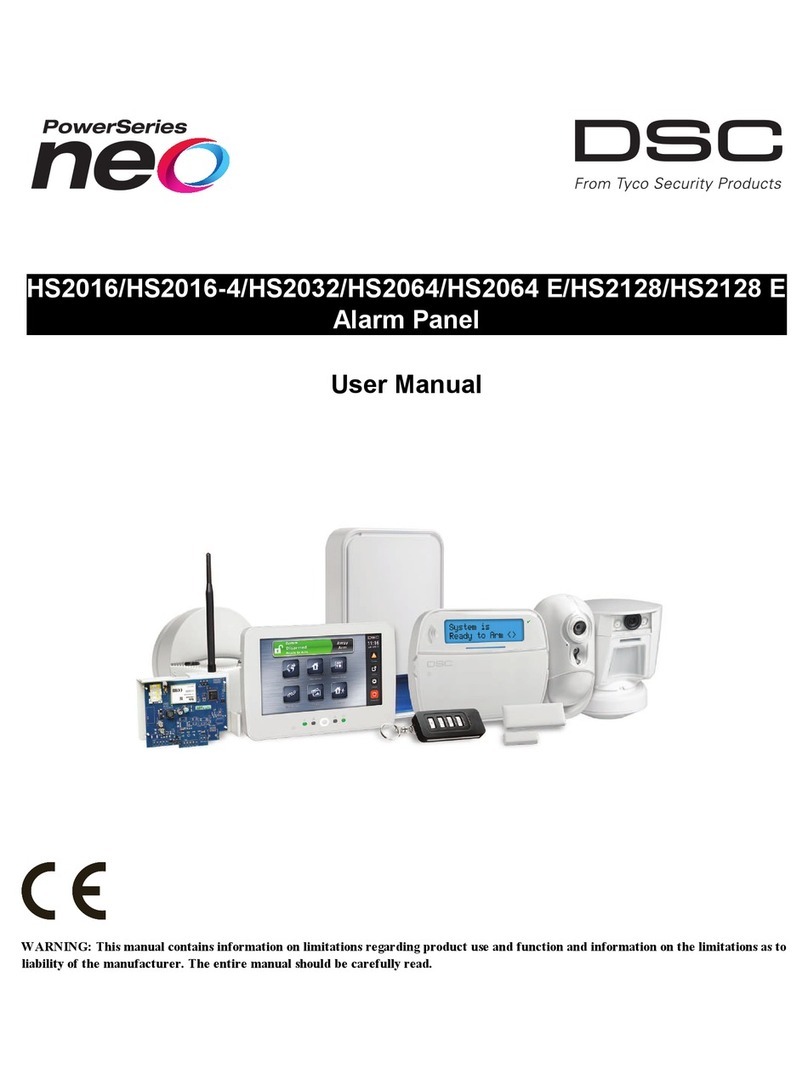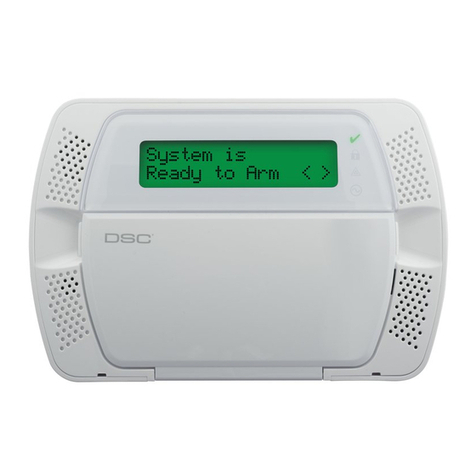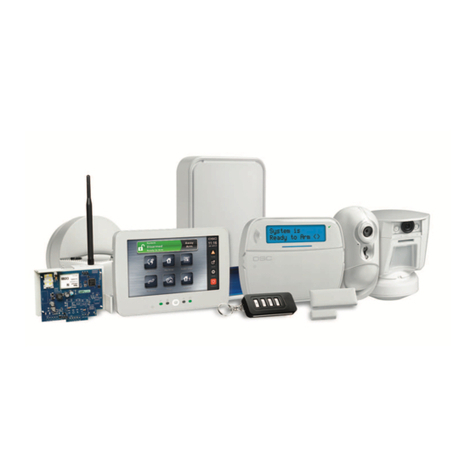
PowerSeries Neo Installation Guide
Safety Instructions for Service Personnel
When using equipment connected to the telephone network, always follow the
basic safety instructions provided with this product. Inform the end-user of the
safety precautions that must be observed when operating this equipment.
Before Installing The Equipment
Ensure your package includes the following items:
lHS2016-4/HS2016/2032/2064/2128 alarm controller
lPower Supply, direct plug-in
lInstallation and user guides, including the safety instructions
Selecting A Suitable Location For The Alarm Controller
Refer to the following list to find a suitable location to install this equipment:
lLocate near a telephone socket and power outlet.
lSelect a location free from vibration and shock.
lPlace alarm controller on a flat, stable surface and follow the installation
instructions.
lDo not locate the equipment where people may walk on the secondary circuit
cable(s).
lDo not connect alarm controller to the same electrical circuit as large appli-
ances.
lDo not select a location that exposes your alarm controller to direct sunlight,
excessive heat, moisture, vapors, chemicals or dust.
lDo not install this equipment near water. (e.g., bath tub, kitchen/laundry
sink, wet basement, near a swimming pool).
lDo not install this equipment and accessories in areas where risk of explo-
sion exists.
lDo not connect this equipment to electrical outlets controlled by wall
switches or automatic timers.
lAvoid interference sources.
lAvoid installing equipment near heaters, air conditioners, ventilators, and
refrigerators.
lAvoid locating equipment close to or on top of large metal objects (e.g., wall
studs).
See "Locating Detectors and Escape Plan" on page 17 for information on locating
smoke and CO detectors.
Safety Precautions Required During Installation
lNever install this equipment and/or telephone wiring during a lightning
storm.
lNever touch uninsulated telephone wires or terminals unless the telephone
line has been disconnected at the network interface.
lPosition cables so that accidents can not occur. Connected cables must not be
subject to excessive mechanical strain.
lUse only the power supply provided with this equipment. Use of unau-
thorized power supplies may cause damage.
lFor direct plug-in versions, use the power supply provided with the device.
WARNING: This equipment has no mains on/off switch. The plug of the direct
plug-in power supply is intended to serve as the disconnecting device if the
equipment must be quickly disconnected. It is imperative that access to the mains
plug and associated mains socket/outlet is never obstructed.
IMPORTANT NOTES
lThis equipment is stationary-fixed with a direct plug-in external transformer
or a permanently connected internal transformer dependent on the region. It
must be installed by Service Persons only (Service Person is defined as a per-
son having the appropriate technical training and experience necessary to be
aware of hazards to which that person may be exposed in performing a task
and of measures to minimize the risks to that person or other persons). It
must be installed and used within an environment that provides the pollution
degree max 2, over voltages category II, in non-hazardous, indoor locations
only.
lThis equipment has no mains on/off switch; if the equipment must be quickly
disconnected, the plug of the direct plug-in power supply is intended to serve
as the disconnecting device. It is imperative that access to the mains plug and
associated mains socket/outlet, is never obstructed.
lFor permanently connected versions, the fuse in the power connector serves
as the disconnecting device. The disconnect device will only remove the
mains power and will not disconnect battery power. The installer is respons-
ible to ensure that a readily accessible mains disconnect device is incor-
porated in the building for permanently connected installations.
lThere are no end user replaceable parts replaceable within this equipment.
lBefore servicing, disconnect the mains power, battery and telephone con-
nections.
lThe equipment enclosure must be secured to the building structure before
operation.
lAll national wiring rules must be observed.
lThe wiring (cables) used for installation of the alarm system and accessor-
ies, shall be insulated with PVC, TFE, PTFE, FEP, Neoprene or Polyamide.
lDo not route any wiring over circuit boards
lEnsure that cables are positioned so that accidents cannot occur:
- Internal wiring must be routed in a manner that prevents;
- Excessive strain or loosening of wire on terminal connections;
- Damage of conductor or insulation.
lDisposal of used batteries must be made in accordance with local waste
recovery and recycling regulations.
lUse authorized accessories only with this equipment.
lDo not place any object on the top of the cabinet.
lDo not spill any liquids on the cabinet.
lDo not touch the equipment and its connected cables during an electrical
storm; there may be a risk of electric shock.
lSave these safety instructions for future use.
lThese safety instructions should not prevent you from contacting the dis-
tributor and/or the manufacturer to obtain any further clarification and/or
answers to your concerns.
Installation
Mounting the Enclosure
Locate the panel in a dry area, preferably near an unswitched AC power source
and the incoming telephone line. Complete all wiring before applying AC or
connecting the battery.
Terminal Descriptions
The following terminals are available on the PowerSeries Neo alarm controller.
Terminal Description
BAT+,
BAT-
Battery terminals. Use to provide backup power and additional current
when system demands exceed the power output of the transformer, such
as when the system is in alarm.
Do not connect the battery until all other wiring is complete.
AC Power terminals.
Connect the battery before connecting the AC. Do not connect the battery
or transformer until all other wiring is complete.
AUX+,
AUX-
Auxiliary terminals. Use to power modules, detectors, relays, LEDs, etc.
(700mA MAX). Connect the positive side of device to AUX+, the
negative side to AUX-.
BELL+,
BELL-
Bell/Siren power (700mA MAX). Connect the positive side of any alarm
warning device to BELL+, the negative side to BELL-.
RED, BLK,
YEL, GRN
Corbus terminals. Use to provide communication between the alarm
controller and connected modules. Each module has four Corbus
terminals that must be connected to the Corbus.
PGM1 to
PGM4
Programmable output terminals. Use to activate devices such as LEDs.
(PGM1, PGM3, and PGM4: 50mA PGM2: 300mA or can be configured
as an input)
Z1 to Z8
COM
Zone input terminals. Ideally, each zone should have one detection
device; however, multiple detection devices can be wired to the same
zone.
EGND Earth ground connection.
TIP, RING,
T-1, R-1
Telephone line terminals.
PCLINK_1 DLS/SA
PCLINK_2 DLS/SA, Alternate Communicator
Corbus Wiring
The RED and BLK Corbus terminals are used to provide power while YEL and
GRN are used for data communications. The 4 Corbus terminals of the alarm
controller must be connected to the 4 Corbus terminals or wires of each module.
The following conditions apply:
lCorbus should be run with minimum 22 gauge quad, two pair twisted pre-
ferred.
lThe modules can be home run to the panel, connected in series or can be T-
tapped.
lDo not use shielded wire for Corbus wiring.
Note: Any module can be connected anywhere along the Corbus. Separate wire
runs for keypads, zone expanders etc. are not necessary.
Note: No module can be more than 1,000'/305m (in wire length) from the panel.
Do not use shielded wire for Corbus wiring.
- 2 -






























